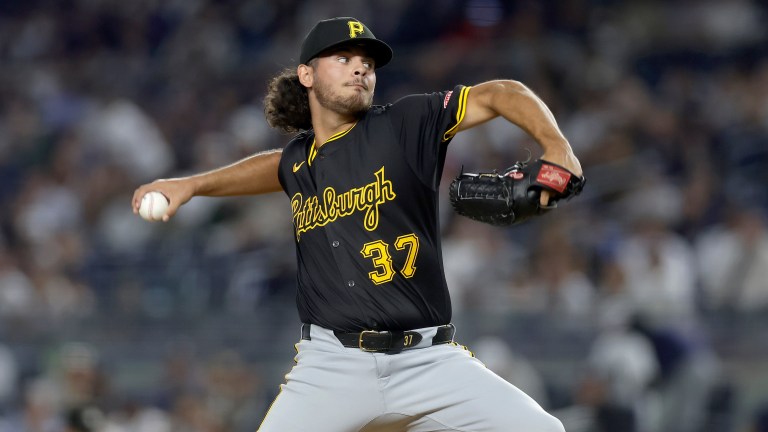What Are the Pittsburgh Pirates Doing and When Will It Stop?
Rather than leaning on a promising rotation heading into 2025, the Pirates are listening to offers on two of their top starting pitchers. This continues a troubling trend for them.

If you happen to have been cursed with the terrible affliction of being a Pittsburgh Pirates fan, the last few decades have been rough. Not only has the team not posted a winning record since 2018, but the 2025 season will mark 10 years since the Pirates last advanced to the playoffs, and 46 years since they last made an appearance in the World Series.
In fact, Pittsburgh has only managed four winnings seasons over the last 30 years, and despite extremely brief moments of excitement (such as drafting Paul Skenes), it’s easy to start wondering whether winning is even the goal.
On December 11, the Pittsburgh Post-Gazette’s Andrew Destin and Noah Hiles reported that the Pirates have made it known that pitchers Mitch Keller and Jared Jones are both available on the trade market this offseason.
“The Pirates have been vocal about their willingness to trade pitching for offense, and sources indicate [Luis] Ortiz was not the only member of last year’s starting rotation available to be dealt,” wrote. “The Post-Gazette learned Monday the Pirates were open to the idea of trading Mitch Keller. A day later, a league source said Jared Jones was also “very available.””
It’s more than a little confusing that the Pirates would be looking to trade away two of their starters this winter. Despite Pittsburgh finishing the 2024 season last in the NL Central with a disappointing 76-86 record, the team found a promising rotation trio in Skenes, Keller, and Jones. All eyes are now on their pitchers to lead the charge into a winning era — if the front office wants it.
The Pirates’ Starting Rotation is Built For the Future
With the Pirates having just found potential in Skenes, Keller, and Jones at the top of their rotation, immediately making two of those three names available for trade is a bizarre step in the wrong direction.
Skenes, who the team selected with the No. 1 pick in the 2023 MLB Draft, has already emerged as the Pirates’ ace of the future. In 23 starts this season, the right-hander went 11-3 with a 1.96 ERA, 0.95 WHIP, and 170 strikeouts in 133 innings of work. As well as becoming the first No. 1 draft pick in MLB history to be selected as an All-Star in his rookie season, Skenes’ impressive campaign saw him named NL Rookie of the Year, selected to the All-MLB First Team, and finish third in Cy Young Award voting.
But the 22-year-old isn’t a one-man operation, and while Jones and Keller didn’t post eye-watering stats to rival Skenes, the Pirates’ 1-2-3 punch is brimming with potential.
Jones made 22 starts in his rookie season this year, posting a 6-8 record, 4.14 ERA, 1.19 WHIP, and 132 strikeouts in 121.2 innings. His 97.3 mph fastball velocity saw him ranked in the 93rd percentile of all qualified pitchers, and his 30.2% whiff rate and 26.2% strikeout rate were both well above average.
Keller, who signed a five-year, $77 million contract extension with the Pirates before the 2024 season, also had a solid campaign, going 11-12 with a 4.25 ERA, 1.30 WHIP, and 166 strikeouts in 178 innings (31 starts). While he didn’t quite meet the standard he set during his 2023 All-Star season, his 6.5% walk rate still ranked him in the 73rd percentile of qualified pitchers.
Admittedly, Jones and Keller both struggled to limit opposing batters’ hard contact on their pitches this season, which is an obvious place for development. Jones’ 89.6 mph average exit velocity was well below league average, while his 44.5% hard-hit rate ranked him in just the 8th percentile across MLB. Keller fared better with his 88.8 mph average exit velocity sitting right on league average, but his 39.3% hard-hit percentage put him in the 44th percentile.
Still, the Pirates’ pitching staff is built for the future, and the front office needs to build around the talented three they’ve stumbled upon, even if it takes more than a season to pay off.
Pittsburgh Needs to Build Around the Existing Talent
The Pirates are looking to fall back into a familiar pattern. Instead of holding onto their stars to build a winning team, they trade them away at the first opportunity, keeping the roster in a constant state of turnover and effectively functioning as a perpetual farm team for the rest of MLB. Even now, with Skenes quickly emerging as an ace for many years to come, they’re reportedly looking to move Jones and Keller, breaking up any potential 1-2-3 punch.
According to the Pittsburgh Post-Gazette, the Pirates are looking to trade Keller to offload the contract he signed only last offseason. Having made $5.8 million in 2024, Keller’s deal sets his salary at $15.4 million next season, $16.9 million in 2026, $18.4 million in 2027 and $20.4 million in 2028.
“The ultimate goal of trading Keller, per sources, would be to trim payroll while also upgrading other areas on the roster,” wrote Destin and Hiles. “Multiple sources said the club’s ideal return would be a young, quality major league bat. Keller’s departure would also create more financial flexibility for additional roster moves.”
In addition to Keller, the Pirates could likely get a much higher trade return for Jones.
“Jones, meanwhile, would be an entirely different type of move,” Destin and Hiles continued. “Viewed by some to be in the upper tier of the game’s intriguing young arms, the 23-year-old right-hander would have a much higher price tag due to his potential, league-minimum contract and multiple years of remaining control.”
If the Pirates are simply looking to continue the constant system of roster turnover, trading Keller and Jones makes sense. The team would trim payroll from Keller and bank high on Jones’ future potential, while bolstering the batting lineup enough to pretend there’s a goal of winning, thereby keeping fans placated for at least another year or two. But if Pittsburgh actually wants to seriously compete in any season in the foreseeable future, this cycle needs to break.
To be clear, it’s pretty unlikely that the Pirates are going to start spending Juan Soto money any time soon, but trading Keller as soon as he hits the expensive part of his deal is more than a little embarrassing. The largest contract in the team’s history is outfielder Bryan Reynolds’ 8-year, $106.75 million extension that he signed before the 2023 season, and while nothing to scoff at as a deal itself, it’s simply not keeping up with the current state of MLB.
So have the Pirates effectively just given up? Have they just accepted that with the gap continuing to widen between big and small market teams, winning is no longer a reasonable thing for them to aim for? Has the current cost of doing business in baseball turned the Pirates into a minor league team with a major league name?
As of right now, not necessarily.
Since Pirates general manager Ben Cherington joined the front office at the end of 2019, the team’s adjusted payroll has slowly increased each year. Pittsburgh’s 2024 payroll came in at just over $84 million, according to Spotrac, which was a decent increase from $74.7 million in 2023 and $56.2 million in 2022. Going into 2025, the Pirates already have just over $42 million allocated.
While they’re obviously not going to spend the same money as the New York Mets, Cherington is moving things in the right direction. Still, the reality is that like all small-market teams, the Pirates need to be creative with their payroll and how they bolster their roster before 2025. That will likely mean turning to the trade market, which isn’t inherently a bad thing. The issue is that Pittsburgh needs to be smart about what they’re willing to sacrifice, and stripping the pitching to add bats is unlikely to be a net positive right now.
According to the Pittsburgh Post-Gazette, Cherington is aware of the risks.
“I mean, obviously, at some point, you got to be careful,” he told Destin and Hiles. “We want to maintain [pitching] as a strength and you go too far, you start to dig into it too much and all the sudden, you can get yourself in trouble. So we’ll need to be thoughtful and careful about it. Still feel like that’s an area of strength and depth. We’ll just have to see what comes. We’re still interested in adding to the team. We think there’ll be a lot of opportunities to do that. We don’t feel like we’re in a rush to do that. We’ll stay after it and we got a couple more months to work on it.”
So can Cherington steer the ship away from sacrificing valuable players to feed an endless cycle of rebuilding? Old habits die hard, but maybe the next 30 years of Pirates fandom doesn’t have to be as brutal as the last.
